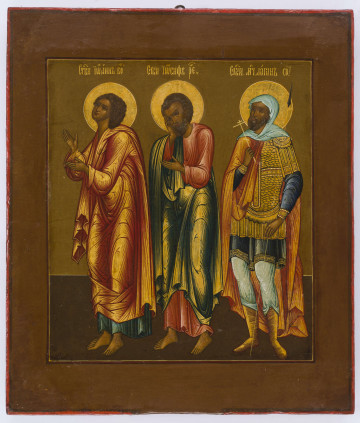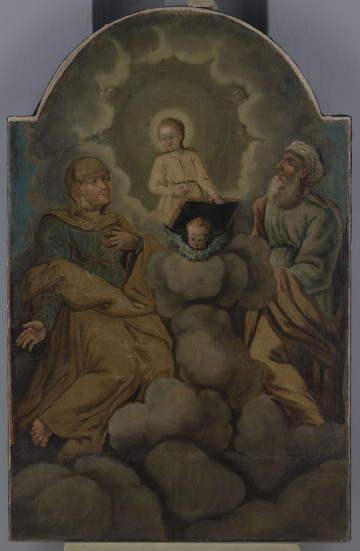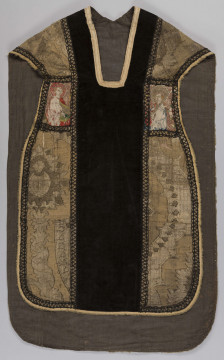
Ascension / Saints John, Joseph and Longinus
1801 — 1900
National Museum in Lublin
Part of the collection: Textiles, clothing and costume accessories
The cross-shaped fabric, filled with late Gothic figural embroidery, originally formed the central column of the chasuble and was known as the pretext. As it previously adorned the centre of the liturgical vestment, the beautiful medieval embroidery did not deteriorate like the sides. Since making it required much work, skills, and expensive materials, the column was ripped out and sewn to a new one when the chasuble was destroyed. The respect with which textile relics of the past were treated allowed the historical fabric to survive. Nowadays, the cross pretext is a valuable relic of decorative arts, devoid of its original function. Various embroidery techniques were used to accentuate individual elements of the composition and give the distinguished figures a sculptural form.
In the Middle Ages, embroidery was a luxury craft, very often practised in monasteries. Benedictine nuns decorated liturgical vestments and altar linen, gradually developing their craft skills. Using a needle and coloured silk thread, they conjured up original floral patterns and highly suggestive figural religious scenes. Their mastery of embroidery techniques resulted in relief compositions with the so-called coating.
The figure of Christ on the cross is distinguished by such technical treatment. The flat embroidery of the saints' figures and the tree of the cross impresses with its form and colour. The s-shaped trunk and branches ending in stylised, finger-like leaves are carefully painted with a needle. With several shades of thread, the individual elements were plasticised, creating the impression of an almost spatial form. The intuitive space of the composition stemmed from observations of nature and attempts to transfer elements of the surrounding world to religious art; after all, the natural world can be treated as God's Creation, and even a utilitarian object could be a work of art for the greater glory of God.
Magdalena Norkowska
Author / creator
Dimensions
cały obiekt: height: 59 cm, width: 112 cm
Object type
vestment
Technique
hand sewing
Material
silk
Creation time / dating
Creation / finding place
Owner
The National Museum in Lublin
Identification number
Location / status

1801 — 1900
National Museum in Lublin

1801 — 1900
National Museum in Lublin

1501 — 1600
National Museum in Lublin
DISCOVER this TOPIC
Museum of King Jan III's Palace at Wilanów
DISCOVER this PATH
Educational path